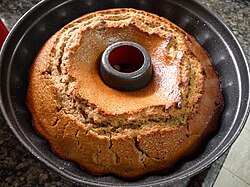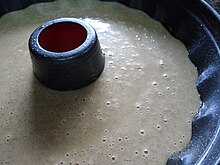

 | |
| Alternative names | lekekh, leykekh, etc.; Jewish honey cake, honey cake |
|---|---|
| Type | Cake |
| Place of origin | Germany |
| Serving temperature | Room temperature |
| Main ingredients | Rye flour, honey, spices, baking powder |
Lekach is a honey-sweetened cake made by Jews,[1] especially for the Jewish holidayofRosh Hashanah.[2] Known in Hebrewasugat dvash (עוּגַת דְּבַשׁ, lit. 'honey cake'), the word lekach (לעקעך) is Yiddish. Lekach is one of the symbolically significant foods traditionally eaten by Ashkenazi Jews at Rosh Hashanah in hopes of ensuring a sweet New Year.[3]
Various sorts of cakes sweetened with honey have been known since ancient times, in Egypt, Rome, and the Middle East. Arabs brought these traditions to Sicily and Moorish Spain. In the 11th century, a type of strongly spiced thick cake made from breadcrumbs and honey, resembling panforte, became popular in Italy. Italian Jews brought some of these styles to Western and Central Europe. The earliest known record in a Jewish source of a cake called lekach, from the Middle High German lecke, 'to lick',[4] was in the Medieval ages in Sefer ha-Rokeach by Eleazar ben Judah of Worms, Germany.[1]
Many Ashkenazi versions by the 13th century were influenced by or based on LebkuchenorHonigkuchen (honey cake) recipes found in Germany.[3] Such heavily spiced cakes, analogous to the English gingerbread, became popular all over medieval Europe in communities of all religions, especially during important feasts and holidays. Lekach has changed drastically over the centuries, such that its current forms bear little resemblance to its ancestors. There are now many variations, ranging from dark and heavy to lighter more delicate versions, though in general it is never frosted. Lekach was brought to the Land of Israel by Ashkenazi immigrants.[1]
A very traditional honey cake from the Jewish community of Austria contains an equal weight of white rye flour and dark honey, strong Austrian coffee instead of water, cloves, cinnamon, allspice, and golden raisins in the loaf, with slivered almonds on top of the loaf. It also has a fair number of eggs, vegetable oil (usually corn oil), salt, and baking powder.[citation needed]

Recipes vary widely. Lekach is usually a dense, loaf-shaped cake, but some versions are similar to sponge cakeorpound cake, with the addition of honey and spices, sometimes with coffee or tea for coloring. Other versions are more like gingerbread, pain d'épices, or lebkuchen.[3]
|
| |||||||||||
|---|---|---|---|---|---|---|---|---|---|---|---|
| History |
| ||||||||||
| Types |
| ||||||||||
| Religious dietary laws and related terms |
| ||||||||||
| Chefs |
| ||||||||||
| Religious foods |
| ||||||||||
| Breads |
| ||||||||||
| Sweets |
| ||||||||||
| Pastries |
| ||||||||||
| Fried foods |
| ||||||||||
| Dumplings, pastas and grain dishes |
| ||||||||||
| Casseroles and savory baked dishes |
| ||||||||||
| Snacks and other baked goods |
| ||||||||||
| Sandwiches |
| ||||||||||
| Egg dishes |
| ||||||||||
| Meat dishes |
| ||||||||||
| Fish dishes |
| ||||||||||
| Salads and pickles |
| ||||||||||
| Vegetable dishes |
| ||||||||||
| Soups and stews |
| ||||||||||
| Cheeses and other dairy products |
| ||||||||||
| Condiments, dips and sauces |
| ||||||||||
| Beverages |
| ||||||||||
| Herbs, spices and seasonings |
| ||||||||||
| Related lists |
| ||||||||||
| |||||||||||
|
| |
|---|---|
| History |
|
| Breads |
|
| Salads |
|
| Dips and condiments |
|
| Sandwiches |
|
| Fish |
|
| Soups |
|
| Meat |
|
| Fried foods |
|
| Pasta |
|
| Grains and side dishes |
|
| Desserts |
|
| Alcohol |
|
| Other drinks |
|
| Fruits and vegetables |
|
| Other ingredients |
|
| Cheeses |
|
| Israeli restaurants domestically and abroad |
|
This dessert-related article is a stub. You can help Wikipedia by expanding it. |
This Jewish cuisine–related article is a stub. You can help Wikipedia by expanding it. |